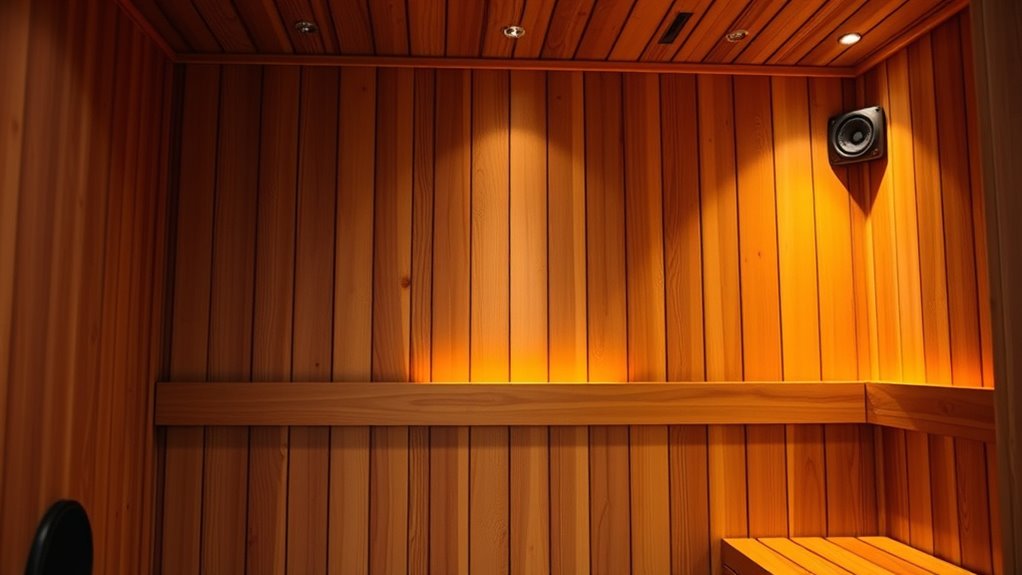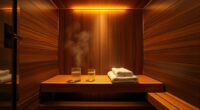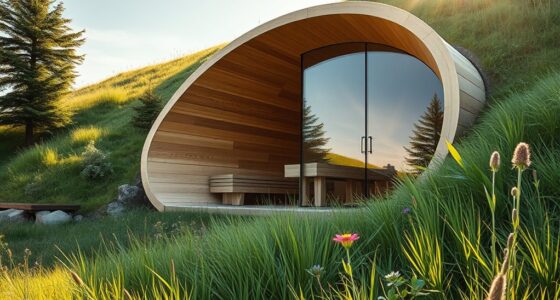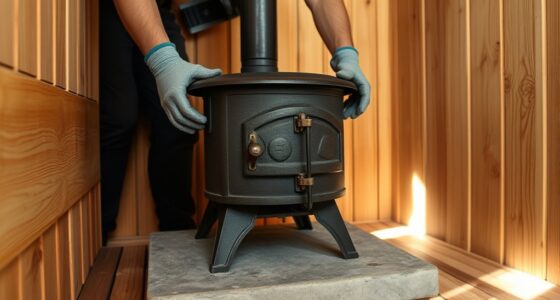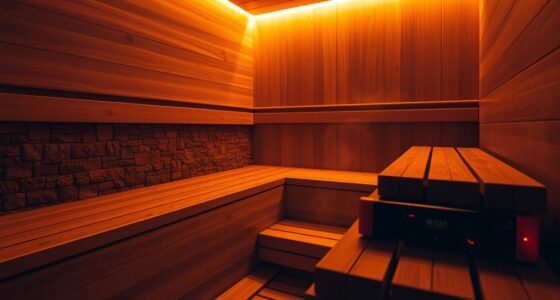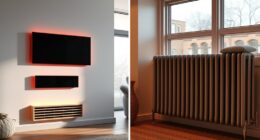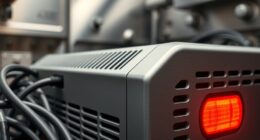Adding sound and music to your sauna can seem simple, but it hides costs like moisture damage, safety risks, and higher maintenance. Moisture causes corrosion and short circuits, leading to costly repairs. Poorly sealed equipment can be a fire hazard, and noise may disturb others. Compatibility issues with heating systems can also drive up expenses. To avoid these pitfalls, you need to choose the right gear and install it properly. Learn more to protect your investment.
Key Takeaways
- Inadequate moisture protection can cause corrosion, leading to costly repairs and shortened equipment lifespan.
- Excessive volume and improper soundproofing increase energy use and risk of equipment damage.
- Poor installation or incompatible systems can result in unexpected maintenance costs and safety hazards.
- Lack of accessibility hampers quick repairs, raising labor costs and prolonging downtime.
- Neglecting environmental controls may cause mold and material deterioration, incurring hidden long-term expenses.
Risks of Moisture Damage to Audio Equipment
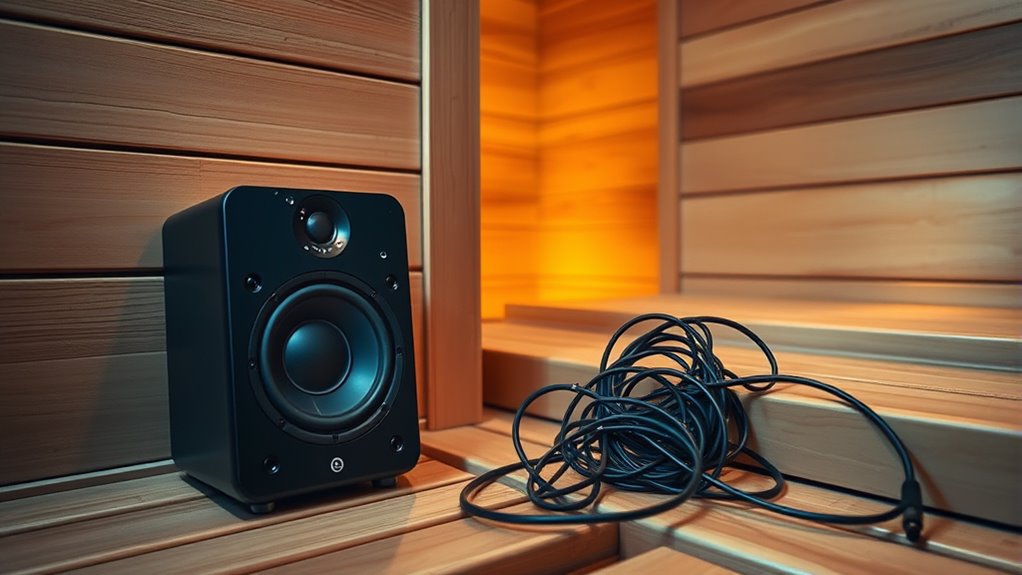
Moisture is one of the biggest threats to audio equipment in sauna rooms, and if you’re not careful, it can cause significant damage. Excess humidity can lead to corrosion of internal components, degrading audio quality over time. Without adequate moisture protection, your speakers and devices are vulnerable to rust and short circuits, which may result in costly repairs or replacements. Even small amounts of condensation can impact sound clarity and volume, making your audio experience less enjoyable. To avoid these issues, invest in equipment designed for high-humidity environments and ensure seals are intact. Using waterproof enclosures and moisture-resistant materials helps safeguard your audio setup, preserving both sound quality and longevity. Proper moisture protection is essential to maintain superior audio performance in sauna rooms. Additionally, implementing proper ventilation can significantly reduce moisture buildup, further protecting your equipment from damage.
Impact on Sauna Environment and Material Longevity
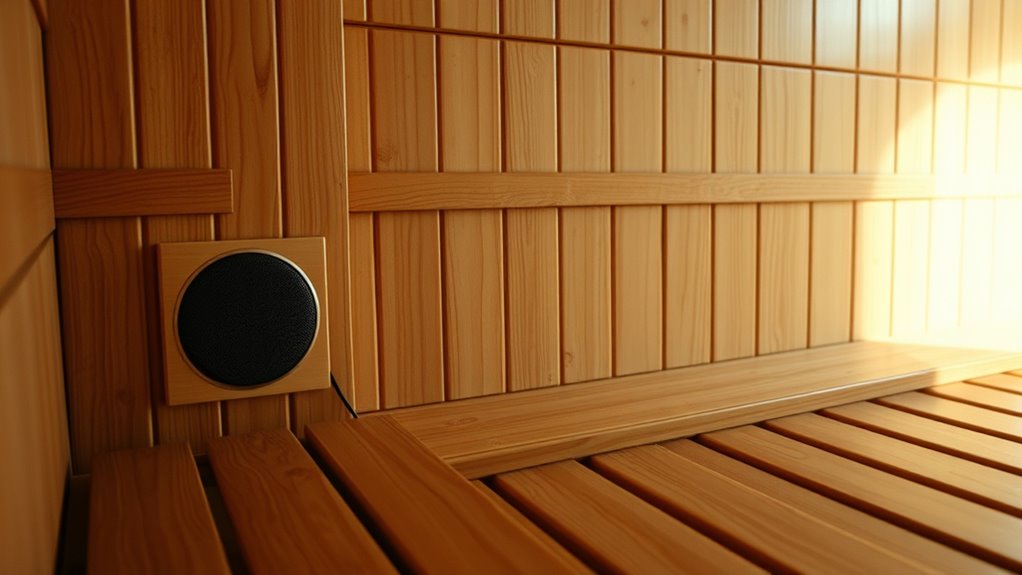
Sound and music equipment in sauna rooms can considerably impact the environment by introducing vibrations and noise that may disrupt the tranquil atmosphere. These disturbances can accelerate material degradation and worsen humidity effects on surfaces. Continuous vibrations can loosen fittings, crack panels, and weaken structural integrity over time. Elevated humidity from sound equipment may promote mold, wood warping, and deterioration of sensitive materials. To minimize these issues, consider:
- Using vibration-dampening mounts
- Installing waterproof, humidity-resistant components
- Regularly inspecting for signs of material wear
- Maintaining proper ventilation to control humidity levels
- Incorporating automation technologies to monitor and optimize environmental conditions
Ignoring these factors could shorten the lifespan of your sauna’s materials and compromise its peaceful setting. Proper precautions help preserve both the environment and the longevity of your sauna’s structure.
Increased Energy Usage and Operational Costs
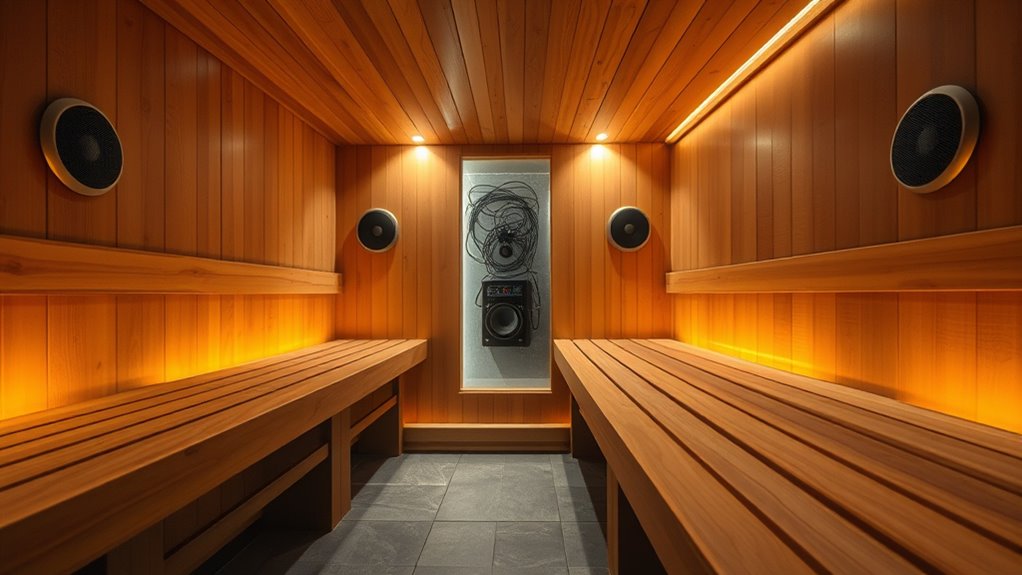
When you add sound systems to your sauna, you’ll notice increased energy demands from the amplifiers. These devices often operate inefficiently, wasting power and driving up your operational costs. Understanding these hidden expenses can help you manage your sauna’s energy use more effectively.
Amplifier Power Demands
Because amplifiers require significant power to deliver high-quality sound in sauna rooms, their energy demands can quickly add up. Poor amplifier efficiency means you’ll consume more electricity, increasing operational costs. To reduce this, focus on power optimization strategies such as selecting energy-efficient models and managing volume levels carefully. Keep in mind:
- Higher wattage amplifiers demand more energy
- Inefficient amplifiers waste power as heat
- Overpowered systems run unnecessarily
- Proper tuning can minimize power consumption
- A better understanding of power management can help optimize your setup and reduce costs.
Sound System Inefficiencies
Inefficient sound systems can substantially drive up energy consumption and operational costs in sauna rooms. Poor audio quality often results from improperly placed speakers, causing the system to work harder to deliver clear sound. When speakers aren’t ideally positioned, you may need higher amplifier power or additional equipment to compensate, increasing energy use. Additionally, subpar speaker placement can lead to uneven sound distribution, forcing the system to run longer or at higher volumes, further raising costs. To avoid these inefficiencies, focus on strategic speaker placement that maximizes audio quality while minimizing power demands. Proper positioning ensures clear sound coverage with less effort from your equipment, reducing both energy consumption and operational expenses.
Safety Hazards From Electrical Components in Moist Conditions

Electrical components in sauna rooms pose significant safety risks if they are not properly protected against moisture. Moisture hazards can lead to electrical safety issues, including shorts, sparks, or even fires. To prevent these dangers, you must guarantee proper insulation and sealing of all electrical parts. Failure to do so increases the risk of shock or electrocution. Additionally, using waterproof and corrosion-resistant wiring is essential for maintaining electrical safety in moist environments. Be vigilant about:
- Using waterproof and corrosion-resistant wiring
- Installing GFCI outlets for added protection
- Regularly inspecting for moisture buildup
- Ensuring all electrical enclosures are sealed tightly
Ignoring these safety measures can result in serious accidents. Protect yourself and others by addressing moisture hazards promptly and maintaining strict electrical safety standards in your sauna.
Noise Disturbance to Others and Neighborhoods
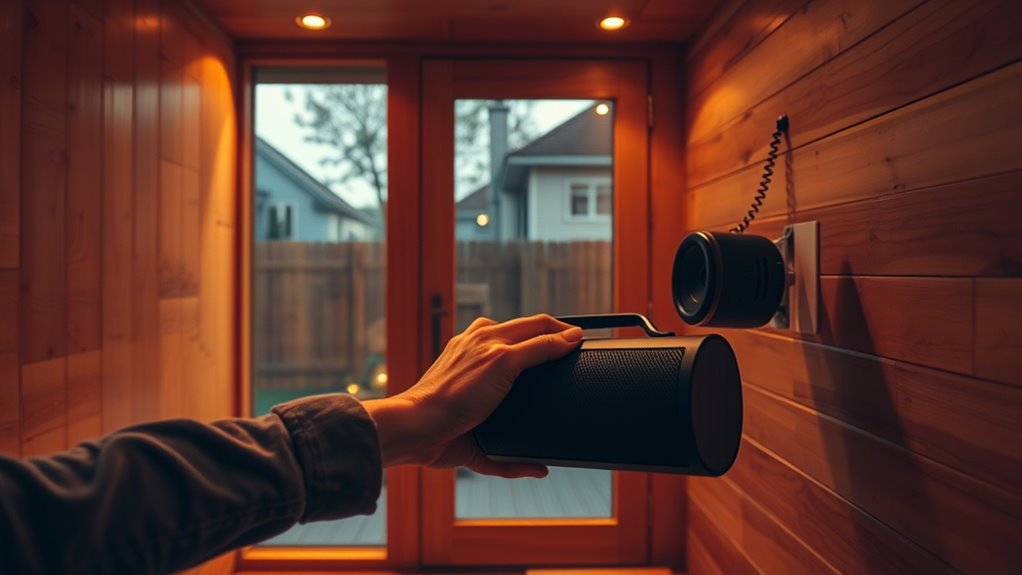
While enjoying the relaxation of a sauna, it’s easy to overlook how noise can affect others nearby. Uncontrolled music or sounds can lead to neighborhood noise complaints and strained relationships. Soundproofing challenges make it hard to contain noise, especially in shared or close quarters. To minimize disturbance, consider these factors:
| Factor | Impact | Solution |
|---|---|---|
| Sauna location | Proximity to neighbors | Choose secluded spots or add barriers |
| Sound system volume | Excessive levels | Keep volume low or use headphones |
| Building materials | Transmission of sound | Use sound-absorbing insulations |
| Community regulations | Noise restrictions | Follow local noise ordinances |
Additionally, understanding the importance of attention in creative practice can help you focus better on sound management, leading to more effective noise control strategies.
Challenges of Proper Soundproofing and Insulation
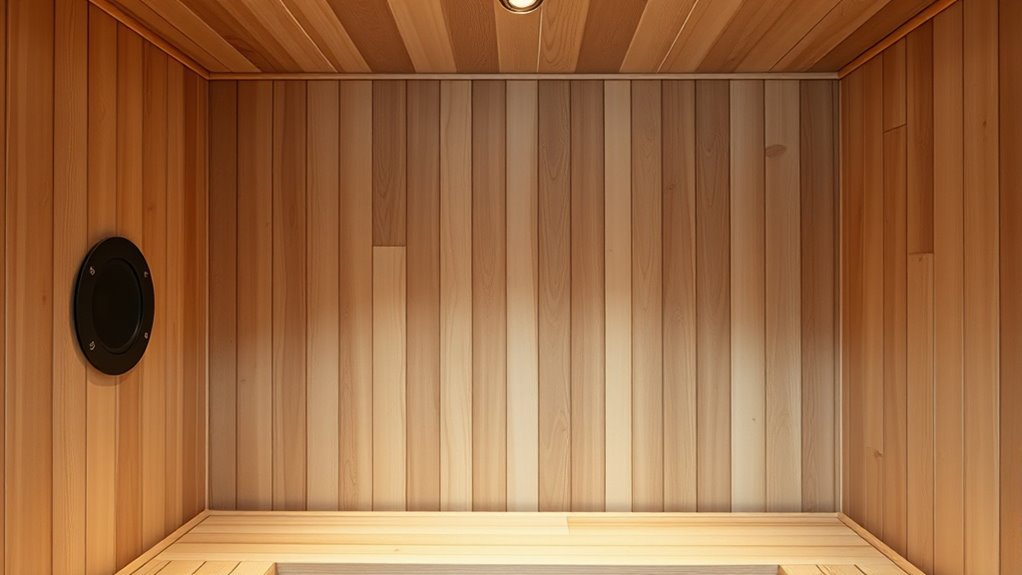
Proper soundproofing and insulation in sauna rooms present significant challenges because achieving effective noise containment requires careful selection of materials and construction techniques. You might face soundproofing challenges like noise leakage through walls or floors, which can disturb others. Insulation issues, such as heat loss or moisture buildup, can also compromise the sauna’s comfort and safety. To minimize these problems, consider:
Effective sauna insulation and soundproofing require careful material selection and precise construction techniques.
- Using dense, vibration-dampening materials
- Sealing gaps and cracks thoroughly
- Incorporating moisture-resistant insulation
- Ensuring proper layering for thermal and sound insulation
Effective soundproofing techniques are essential for maintaining a quiet and energy-efficient sauna environment. Addressing these soundproofing challenges and insulation issues demands attention to detail, or else you risk increased energy costs, discomfort, and potential noise complaints. Proper planning helps you create a sauna that’s both quiet and well-insulated.
Compatibility Concerns With Sauna Heating Systems
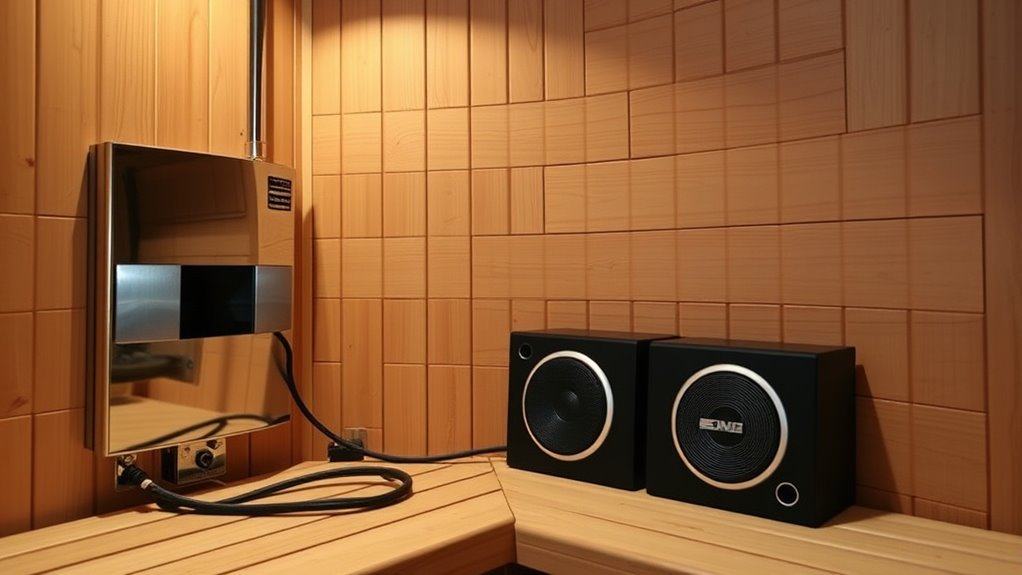
Choosing the right heating system for your sauna is essential to guarantee compatibility with your soundproofing and insulation efforts. Confirming your sauna heater meets safety regulation compliance is critical to prevent hazards and maintain a safe environment. You need to verify sauna heater compatibility with your existing setup to avoid electrical issues or damage that could compromise both safety and performance. Different heating systems, whether electric or wood-burning, have unique requirements and limitations. Mismatched heaters may cause noise disturbances or interfere with soundproofing efforts. Before installation, check that your chosen heater aligns with your sauna’s specifications and your soundproofing measures. Proper compatibility reduces the risk of costly adjustments later and ensures your sauna remains a safe, relaxing space.
Potential for Distraction and Reduced Relaxation Benefits
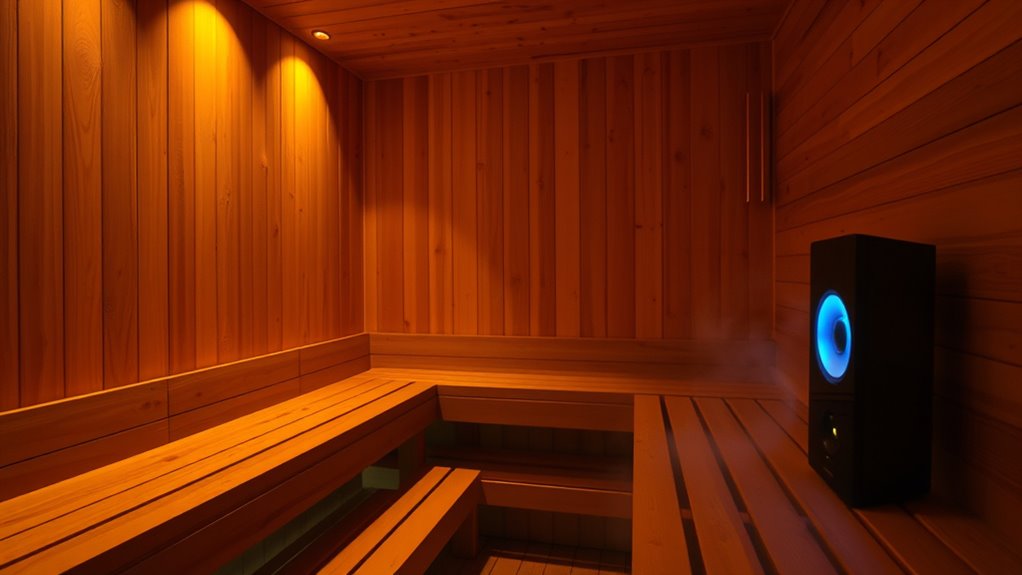
Introducing sound and music into your sauna can sometimes backfire by causing distractions that diminish your relaxation. When noise becomes a visual distraction or an unexpected sound, it can impair your focus and pull you out of the calming moment. Instead of unwinding, you might find yourself more aware of the surroundings or struggling to concentrate on relaxation. To avoid this, consider these potential pitfalls:
Introducing sound in your sauna can cause distractions that hinder true relaxation and focus.
- Unexpected loud sounds breaking the tranquil atmosphere
- Visual distractions from blinking lights or moving devices
- Overlapping noises that impair concentration
- Disrupted focus due to inconsistent music volume
- Recognizing the importance of sound quality can help maintain a peaceful environment.
These issues can reduce the effectiveness of your sauna session, making it harder to achieve true relaxation and mental clarity. Being mindful of these distractions can help preserve the calming benefits of your sauna experience.
Difficulties in Maintaining and Repairing Audio Devices
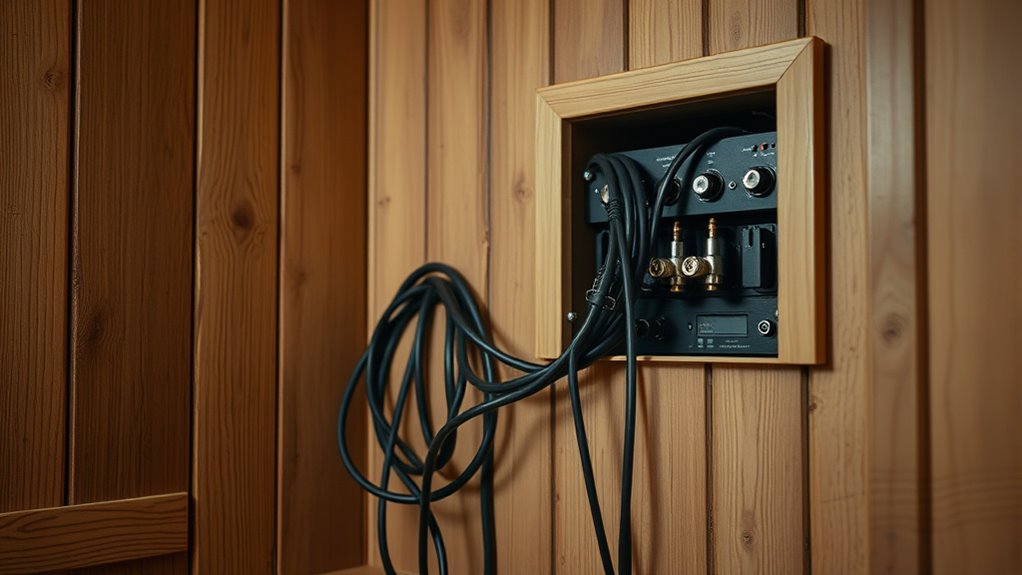
Maintaining and repairing audio devices in sauna rooms can be challenging because moisture causes corrosion and damages components. Additionally, limited access makes it hard to perform necessary repairs without disrupting the environment. These issues can lead to increased costs and more frequent equipment failures. Regular inspection and proper maintenance can help mitigate performance issues caused by moisture exposure.
Moisture-Induced Corrosion Risks
Moisture-induced corrosion considerably complicates the maintenance and repair of audio devices in sauna rooms. The humid environment accelerates corrosion risks, making components more vulnerable over time. You might notice that exposed metal parts rust quickly or develop electrical faults, leading to costly repairs or replacements. To prevent these issues, watch out for:
- Corrosion on connectors and circuit boards
- Short circuits caused by moisture buildup
- Degradation of insulation and protective coatings
- Reduced lifespan of speakers and audio equipment
These risks demand extra attention, as moisture can silently damage devices, making troubleshooting difficult. Without proper protection, repair costs escalate, and your audio setup’s reliability diminishes. Additionally, AI-driven security systems can help monitor environmental conditions and alert you to excessive humidity levels, further safeguarding your equipment. Guard against moisture exposure to keep your sound system functioning most effectively and avoid costly maintenance.
Limited Access for Repairs
Accessing and repairing audio devices in sauna rooms can be more challenging than in typical environments because their placement often limits easy reach. The harsh conditions and compact design create access restrictions that complicate maintenance. You might find that repair limitations are frequent, as specialized tools or disassembly become necessary to reach components. These constraints mean repairs take longer and may require professionals, increasing costs and downtime. Additionally, the confined space can make troubleshooting difficult, risking further damage. When installing sound systems, consider how access restrictions could impact future repairs. Failing to account for these limitations now might lead to more frequent or costly repairs later. Incorporating style considerations can help optimize accessibility and reduce future repair challenges. Ultimately, limited access can compromise your ability to maintain audio devices efficiently, adding hidden costs you should plan for.
Hidden Costs of Upgrading or Replacing Subpar Equipment
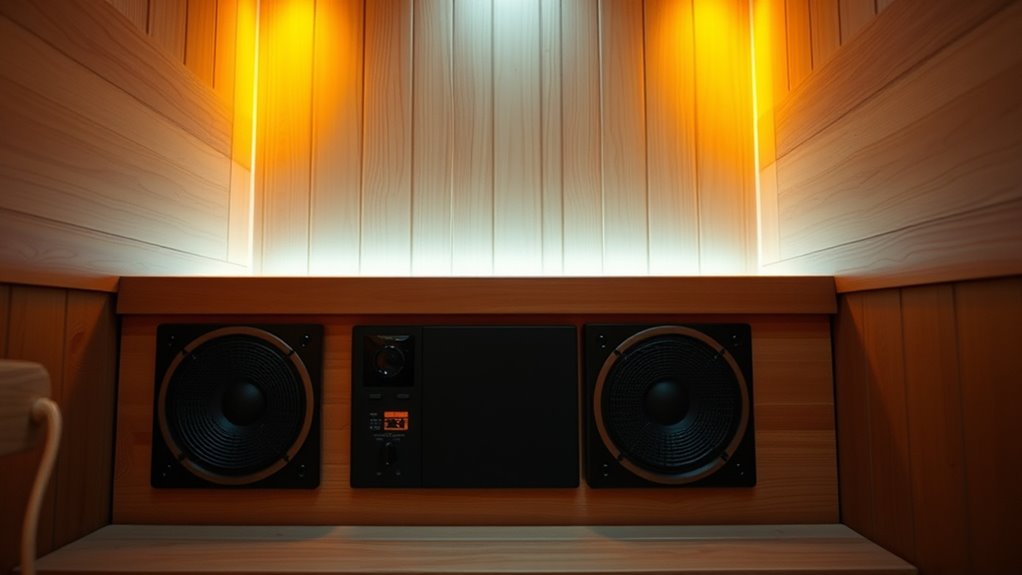
Upgrading or replacing subpar sound and music equipment in your sauna might seem straightforward, but the hidden costs can catch you off guard. A thorough cost analysis is essential to avoid surprises. Poor equipment compatibility can lead to additional expenses, such as needing adapters or new wiring. Unexpected issues may arise during installation, increasing labor costs. You might also face ongoing maintenance or upgrade costs if the new system isn’t durable or compatible with your existing setup. Consider these hidden costs:
- Additional parts or adapters for equipment compatibility
- Increased labor for complex installations
- Future maintenance or upgrades
- Potential damage from improper setup
Being aware of these factors helps you make smarter choices, saving money and hassle in the long run. Proper planning ensures your upgrade enhances your sauna experience without unexpected financial burdens.
Frequently Asked Questions
How Can I Ensure Sound Equipment Is Moisture-Resistant for Sauna Use?
To guarantee your sound equipment is moisture-resistant for sauna use, you should choose waterproof speakers specifically designed for humid environments. Look for speakers made with moisture-proof materials like sealed enclosures and corrosion-resistant components. Additionally, verify that the equipment has an IP rating indicating its level of water resistance. Proper installation and regular maintenance also help prevent moisture damage, ensuring your sound system stays functional and safe in the high-humidity sauna atmosphere.
What Are Cost-Effective Ways to Soundproof a Sauna Room?
To soundproof your sauna cost-effectively, start with acoustic treatments like foam panels or mass-loaded vinyl to absorb sound. Use insulation techniques such as mineral wool or foam board within walls and ceilings to prevent noise from escaping. Seal gaps with weatherstripping or acoustic sealant, and opt for budget-friendly materials. These strategies reduce noise transmission without breaking the bank, ensuring a peaceful sauna experience.
How Does Sound System Installation Affect Sauna Warranty and Safety?
You might find that installing a sound system in your sauna impacts your warranty and safety if you’re not careful. Poor installation can void warranty implications and create safety hazards, like electrical issues or moisture damage. To avoid this, follow manufacturer guidelines and choose professional installers who prioritize installation safety. Coincidentally, doing so guarantees your sauna remains safe, functional, and protected, so you can enjoy music without worry or risking your warranty.
Are There Eco-Friendly Audio Options Suitable for Humid Environments?
Yes, there are eco-friendly speakers designed for humid environments. You should look for sustainable audio options like bamboo or recycled material speakers that withstand moisture and heat. Eco-friendly speakers diminish environmental impact and are often energy-efficient, making them perfect for sauna rooms. Investing in these options ensures you enjoy quality sound while supporting sustainability, and they’re built to last in humid conditions without compromising safety or performance.
How Can I Balance Sound Quality With Relaxation in a Sauna Setting?
You can balance sound quality with relaxation by focusing on acoustic optimization in your sauna. Use moisture-resistant speakers placed strategically to guarantee comfortable listening without overwhelming the space. Keep volume levels moderate to maintain a tranquil atmosphere, and choose sound systems designed for humid environments. This approach helps you enjoy high-quality sound while preserving the calming, relaxing vibe essential for a sauna experience.
Conclusion
So, next time you’re tempted to blast your favorite tunes in the sauna, think twice. Sure, it’s a tempting way to turn up the relaxation—until you realize the hidden costs lurking behind that soothing soundtrack. Moisture, damage, higher bills, and safety hazards aren’t exactly the serenade you’d hoped for. Maybe it’s time to embrace the silence and save yourself from a costly, melodramatic mess. Your wallet—and your sanity—will thank you.
